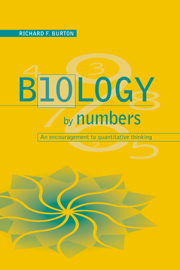Book contents
- Frontmatter
- Contents
- Preface
- A guide to the book
- 1 Putting two and two together
- 2 Units, formulae and the use of old envelopes: confronting some obstacles to quantitative thinking
- 3 Aspects of energy metabolism
- 4 Getting things in proportion
- 5 Perilous percentages, dangerous ratios
- 6 Building a trophic pyramid
- 7 Sodium in animals and plants
- 8 Exchanges of water and carbon dioxide
- 9 A geometric series
- 10 Introduction to logarithms
- 11 Bringing logarithms to life
- 12 Exponential relationships
- 13 Aspects of allometry
- 14 More on allometry, and on quantitative patterns in nature
- 15 How the abundance of food affects rates of feeding
- 16 The characterization of trees and other branching systems
- 17 Epilogue
- References
- Notes
- Index
4 - Getting things in proportion
Published online by Cambridge University Press: 05 June 2012
- Frontmatter
- Contents
- Preface
- A guide to the book
- 1 Putting two and two together
- 2 Units, formulae and the use of old envelopes: confronting some obstacles to quantitative thinking
- 3 Aspects of energy metabolism
- 4 Getting things in proportion
- 5 Perilous percentages, dangerous ratios
- 6 Building a trophic pyramid
- 7 Sodium in animals and plants
- 8 Exchanges of water and carbon dioxide
- 9 A geometric series
- 10 Introduction to logarithms
- 11 Bringing logarithms to life
- 12 Exponential relationships
- 13 Aspects of allometry
- 14 More on allometry, and on quantitative patterns in nature
- 15 How the abundance of food affects rates of feeding
- 16 The characterization of trees and other branching systems
- 17 Epilogue
- References
- Notes
- Index
Summary
Here are some simple problems that differ in biological content, but have, in algebraic terms, very similar solutions. Section 4.1, about human energy balance, follows naturally from Chapter 3. The relation between human fat content and buoyancy (Section 4.2) leads on to buoyancy in fish (Section 4.3), but the final topic (Section 4.5) has to do with a quite different aspect of body composition, namely blood volumes in snails.
Aspects of human heat and energy balance
Starting with a matter of every-day experience, suppose that someone is feeling cold and takes a hot drink to get warm. What difference might it make to the average body temperature if the body mass is, say, 60 kg and the drink has a mass of 0.3 kg (300 ml, perhaps a mugful). The temperature of the drink as it enters the mouth, perhaps cooled by sipping, is unlikely to exceed 63°C, so let us assume that it is 25°C above mean body temperature. There is no need to know the actual body temperature, for only the change is to be calculated. (Note that when one speaks of ‘body temperature’, one generally refers to the temperature of a ‘core’, normally 37°C, that includes the all-important brain; the ‘mean temperature’ includes skin and extremities too, and these are usually cooler. The calculated change will be an average also, due mainly to warming of the cooler parts.) It takes 1 kcal, by its original definition, to raise the temperature of 1 kg of water by 1°C (strictly, from 14.5 to 15.5°C).
- Type
- Chapter
- Information
- Biology by NumbersAn Encouragement to Quantitative Thinking, pp. 51 - 60Publisher: Cambridge University PressPrint publication year: 1998



